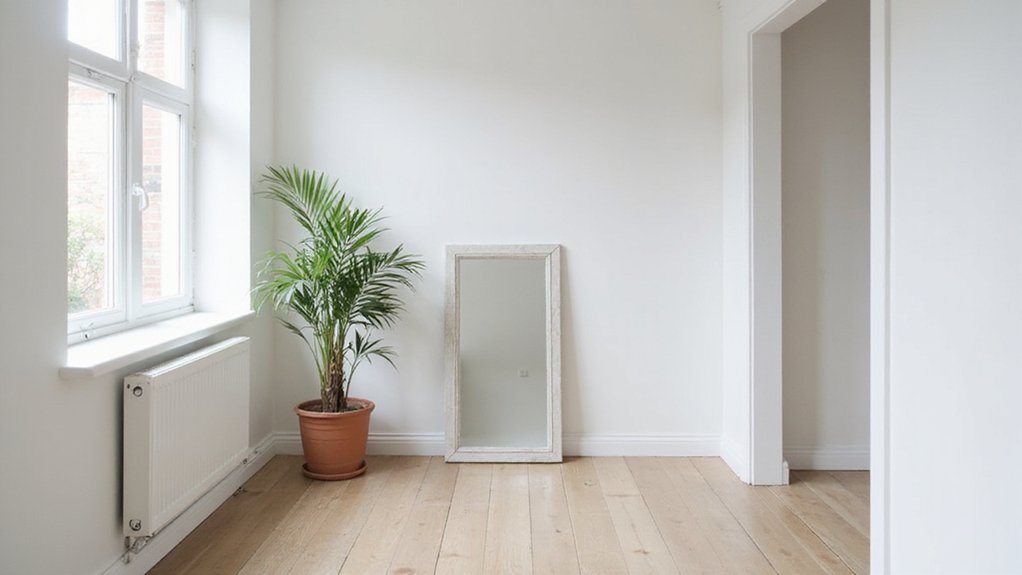You can alter small rooms with strategic painting. By choosing the right colors, you’ll create a sense of space. But how?
Choosing the Right Colors
Because a small room’s color scheme can greatly impact its perceived size, you’ll want to choose colors that create a sense of openness and airflow. You’ll need to ponder the role of color in making your space feel more welcoming.
Warm tones can create a cozy atmosphere, but they can also make a room feel smaller. Neutral palettes, on the other hand, can help reflect light and create a sense of calm. By selecting a neutral palette with a touch of warm tones, you can create a sense of balance and harmony. This approach will help you design a color scheme that makes your small room feel more inviting and inclusive, allowing you to feel a sense of belonging in the space. Choose colors that work well together to create a sense of flow. Additionally, professional painters can offer expert suggestions on color selection strategies to make your small room appear bigger, cozier, or brighter.
Creating the Illusion of Space
You’ll employ various techniques to produce the illusion of space in a small room, and it’s essential to contemplate the room’s dimensions, layout, and natural light.
As you design the space, consider how lighting choices can amplify or diminish the sense of spaciousness. By making intentional lighting choices, you can create a brighter, more airy feel.
You’ll also use visual cues, such as lines and shapes, to guide the eye and create a sense of flow. This helps to draw attention away from the room’s limitations and creates a sense of continuity.
Proven painting techniques can further enhance this effect by making your home space look bigger and brighter.
Painting Techniques for Small Rooms
As you move forward with designing your small room, painting techniques play an essential role in enhancing its visual appeal. You’re creating a sense of belonging by carefully selecting colors and techniques that make the space feel larger.
Using lighter colors on walls and ceilings
Creating focal points with accent walls
Coordinating furnishings with paint colors
Applying paint in a way that creates a sense of height, making the room feel more spacious. By considering these techniques, you can make your small room feel more welcoming and inclusive, which is key to creating a sense of belonging. You’re not just painting a room, you’re creating a space that feels like home.
The Importance of Light Reflectance
When designing a small room, the way paint reflects light can greatly impact its overall ambiance, and it’s crucial to ponder this factor to generate a sense of depth and visual fascination. You’ll want to choose balanced hues that don’t absorb too much light, allowing luminous surfaces to create a brighter atmosphere. By doing so, you’ll create an illusion of a larger space.
Consider the natural light sources in the room and how they interact with the paint color. This will help you select a color that maximizes light reflectance, making the room feel more spacious. With the right paint, you can create a sense of belonging and comfort in your small room, making it feel cozier and more inviting. Balanced hues and luminous surfaces work together to create a harmonious space.
Selecting the Perfect Finish
The finish of your paint is just as essential as its color, and it’s time to contemplate what type of finish will best suit your small room. You’re looking for a finish that creates a sense of belonging and openness. Consider paint sheen options, as they can greatly impact the room’s ambiance.
- Flat finish for low-traffic areas
- Eggshell finish for a subtle sheen
- Satin finish for a balance between durability and appearance
- Semi-gloss finish for high-traffic areas and texture considerations.
Maximizing Natural Light
Since you’re working with a small room, maximizing natural light is essential to create an illusion of more space. You can achieve this by using intentional window treatments that allow natural light to enter the room. Consider using sheer curtains or blinds that filter the light, making the room feel brighter and more airy.
Strategically placed mirrors can also help reflect natural light, creating the illusion of a larger space. By placing a mirror opposite a window, you can bounce natural light into the room, making it feel more spacious. This technique, combined with the right window treatments, will help you create a sense of openness and belonging in your small room. It’s a simple yet effective way to make your space feel more welcoming and expansive.
Designing a Sense of Depth
By incorporating visual elements that create a sense of progression, you can design a sense of depth in your small room, making it feel more lively and engaging. Using contrasting hues and employing visual tricks can help achieve this.
Using lighter colors on walls and ceilings.
Incorporating mirrors to reflect light.
Adding floor-to-ceiling curtains to create height.
Painting a focal wall with a deeper hue to draw the eye in. These techniques will help create a sense of belonging in your newly designed space. By applying these methods, you’ll be able to make your small room feel more spacious and inviting, making it a great place to relax and unwind.
Frequently Asked Questions
Can I Paint Over Wallpaper?
You’ll need to remove or prepare wallpaper first, using proper wallpaper removal techniques and wallpaper preparation tips, before you can paint over it successfully, don’t you?
How Long Does Paint Last?
You’re wondering how long paint lasts, considering its paint lifespan and shelf life, to guarantee you’re using it within its ideal timeframe, don’t you? It typically lasts 5-10 years.
Is Primer Really Necessary?
You’re wondering if primer’s necessary, considering it boosts paint selection and surface preparation, ensuring durability and adhesion, which you’ll appreciate for a flawless finish.
Can I Paint in Cold Weather?
You’re painting outdoors, so use low odor paint and avoid severe temperatures to guarantee a smooth process, creating a welcoming space for you and your community to belong.
Are Paint Fumes Toxic?
You minimize hazardous exposure to paint fumes by using proper ventilation techniques, ensuring a safe space for yourself and others nearby, don’t you?

